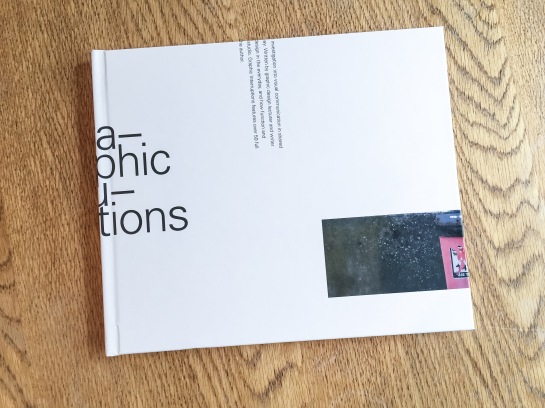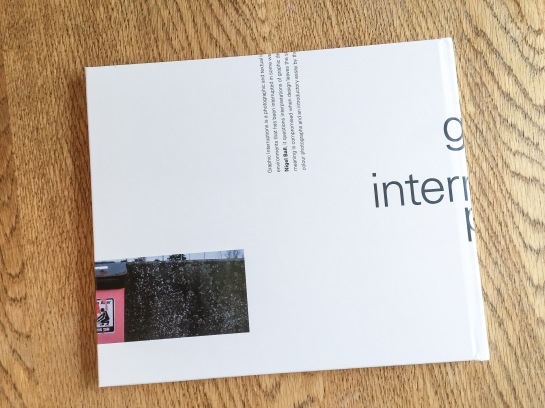
There has been a surge of typography publications dropping through my letterbox recently. They are all very different in their own ways, but one thing unites them all over and above the excellent content, and that is the very high production values. Unfortunately my poor photographic skills won’t do any of them justice, but hopefully will give some indication that these are objects of desire.
Circular 18
The first that hit my door mat recently was Circular 18, the bi-annual publication of the Typographic Circle. Designed by Pentagram’s Domenic Lippa and Jeremy Kunze, and printed by Leycol in the UK, its oversized A4 proportions and clean pages are a thing of beauty.

Interviews with a wide range of typographers and designers, from Ruan Hughes and Harry Pearce to Angus Hyland and Andy Altmann fill the majority of Circular 18 with images of the designers’ work relegated to a few pages at the back of the publication. This allows the focus of the issue to concentrate on the words of the designers through confident typography as conversations about graphic design function and working processes take the lead. There is a real sense that this publication was a labour of love for Lippa and Kunze.


Circular 18 is available free to members of The Typographic Circle, or for £15 to non-members. Email info@typocircle.com for information.
The Recorder
The second magazine I received recently is issue one of the new look The Recorder. Previously published for over 70 years by Monotype, in 2014 it has been relaunched to continue its tradition of looking at the history of typography and contemporary applications.

In its own words: “Making its first appearance in 1902 … it covered everything from technology and typeface releases to historic features; offering readers an in-depth look at the type industry”. It goes on to say of its relaunch issue: “…features both the heritage of typography, and its contemporary application, focussing on how designers have used and responded to type, and how its influence has played a role in our culture and daily lives over the years”. Like Circular 18, its production quality is second to none, with a gold foiled front cover that wraps around the back, and a range of different articles all treated to individual layouts depending on the topics covered. Sized more like a traditional magazine, this is the least conventional thing about this publication. It must have been a daunting publication to revisit, given its revered history, but designer Luke Tonge has managed to give it a contemporary face that respects The Recorder’s legacy and sense of heritage while making it accessable to a new audience.

The content consists of articles, essays, reviews and even a photo essay of the great poster artist / printmaker Alan Kitching.


The Recorder proves to be a critical read, with an excellent article by Sam Roberts on ghostsigns and the ethics of restoration, while Harry Leeson looks at how typography manipulates our relationship with the urban environment and applies theories of class to the field of graphic design. Such depth of discussion in one publication is rare outside of Eye magazine, and The Recorder is a welcome, and beautifully produced, addition to critical design writing.

(As an aside, I came across an original copy of The Monotype Recorder last year, and I was lucky enough for it to be a version dedicated to the life of Stanley Morison. Unfortunately, due to leaving Tumblr and deleting my The Small Letter blog, my digital archive of this is no longer online, but I am planning to resurrect it sometime soon on a different platform.)

The Recorder is available for $17 USD from this dedicated website: click here.
Typograph.journal
Last but by no means least, I stumbled across the new Typograph.journal via various postings from designers I follow on Instagram. Published by Nicole Arnett Phillips, aka Typography.Her, it focusses on design process through her personal reflcetions, case studies of different designer’s approaches to their work, interviews and commissioned exercises. Volume.01, published earlier this year, is titled on its spine: Can A Text Be Both Readerly And Experimental; while the recently published Volume.02 asks: Where Do We Find, And How Do We Feed, Our Creative Energy?


Smaller in scale than the previous publications mentioned here, it has a pocketable quality that belies its depth of discussion and questioning. Like The Recorder and Circular 18, it is inward looking and aimed squarely at graphic designers, typographers and those interested in print processes, but that doesn’t mean that those outside of these fields will not find anything of interest.



Phillips is an Australian designer who certainly understands how to create a visually rich and consuming document. In her own words she states: “I believe rigour and critical design thinking is important. As is a great outcome. But no more so than the design discovery and creative play that happens in the middle”. As an outcome, Typography.journal is both thoughtful and inspirational in its content and production, but equally impressive due to the proud authorship Phillips demonstrates—she is a doer and has made this happen, she self-promotes it through social media and is getting people interested in what is essentially a personal project.


It is also very rewarding to receive Typography.journal through the post as Phillips envelopes the book in its own bespoke wrapping paper and includes print ephemera associated with the release and a hand-written note. This personal approach is a nice touch that reinforces the nature of the publication’s content as well as creating a connection with someone producing such an item half-way around the world.
Typograph.journal 01 & 02 are available to buy either individually or together for $30 AUD from Phillips’ website: click here.
What is really encouraging about these recent publications is that critical design writing is alive and well. Longstanding titles such as Eye, Creative Review, Baseline and the Journal of Design History have their specific areas carved out. And with design blogs being in rude health, it is possible to have questioned whether there was ever going to be any more room, let alone demand, for design writing. Well, these bespoke publications prove that there is a market for well produced high-quality material, both in terms of a physical entity itself, and in terms of content.

































